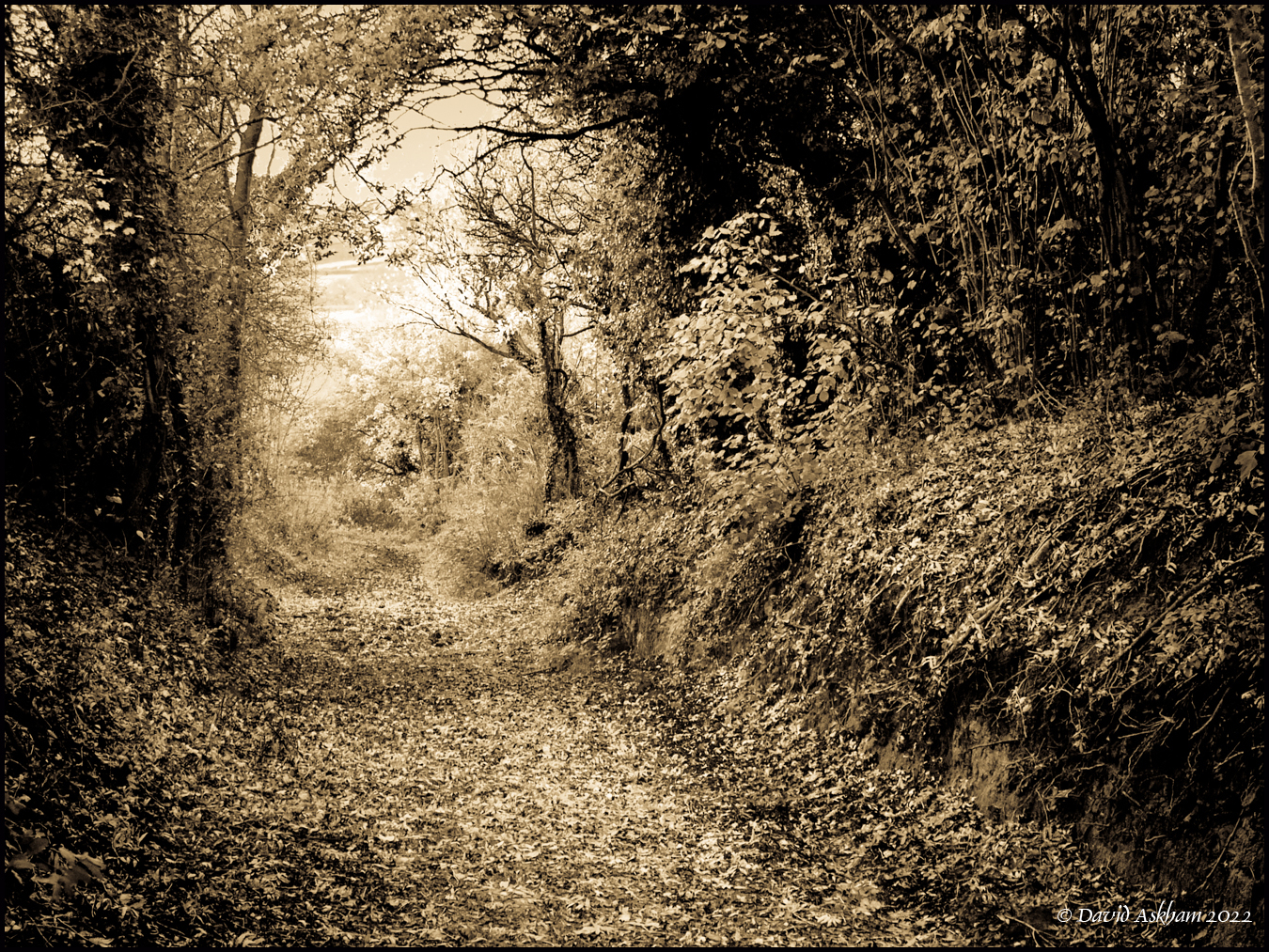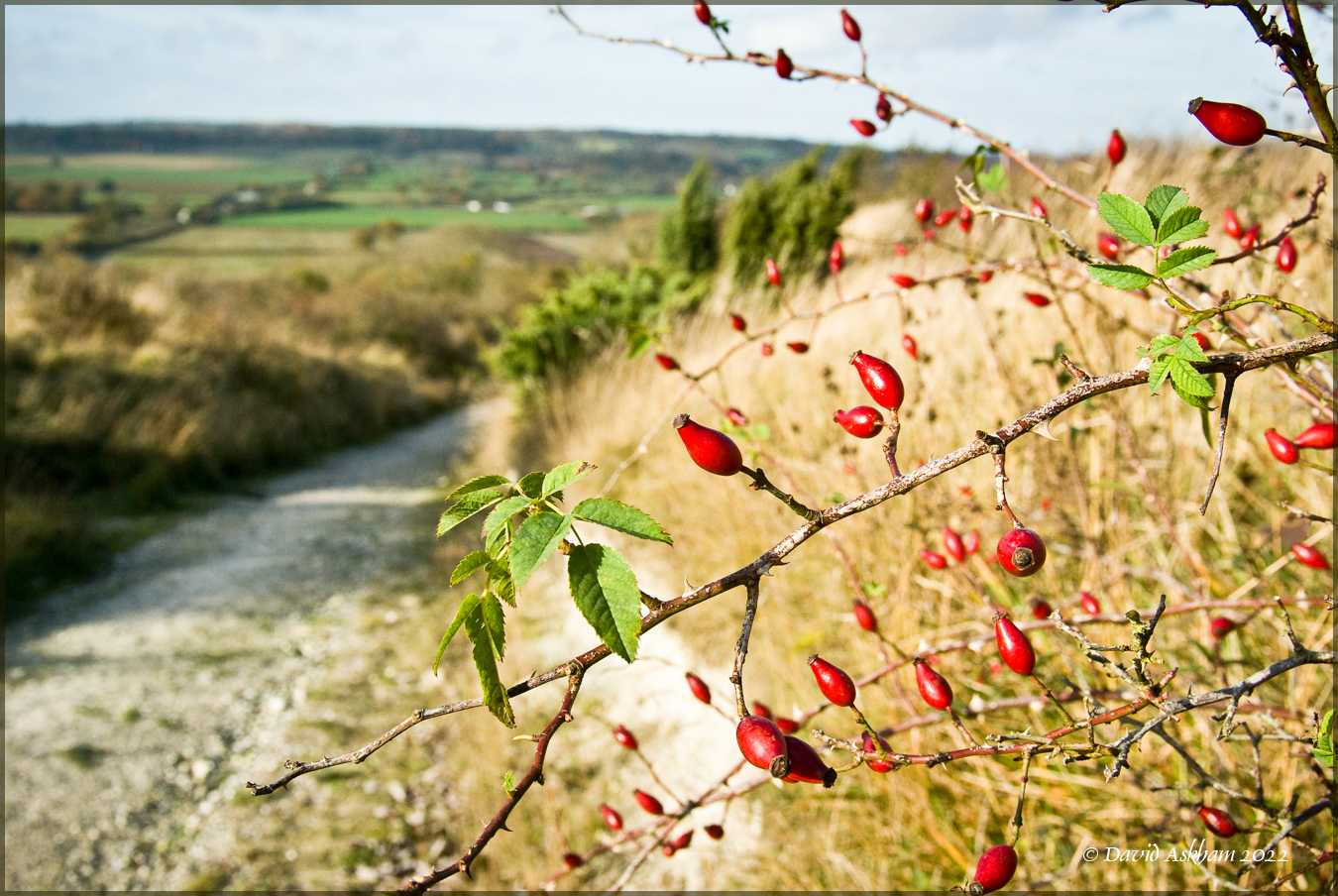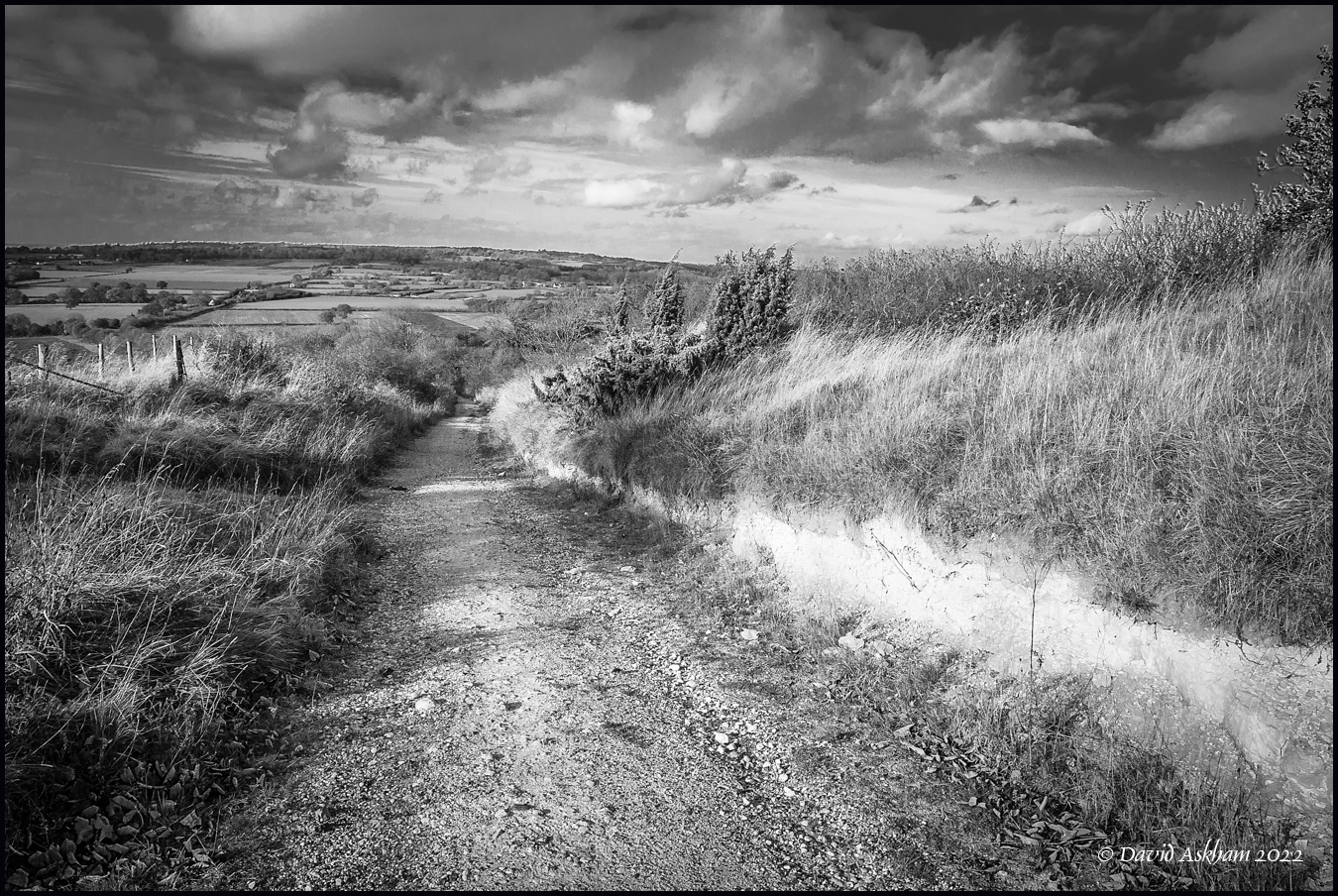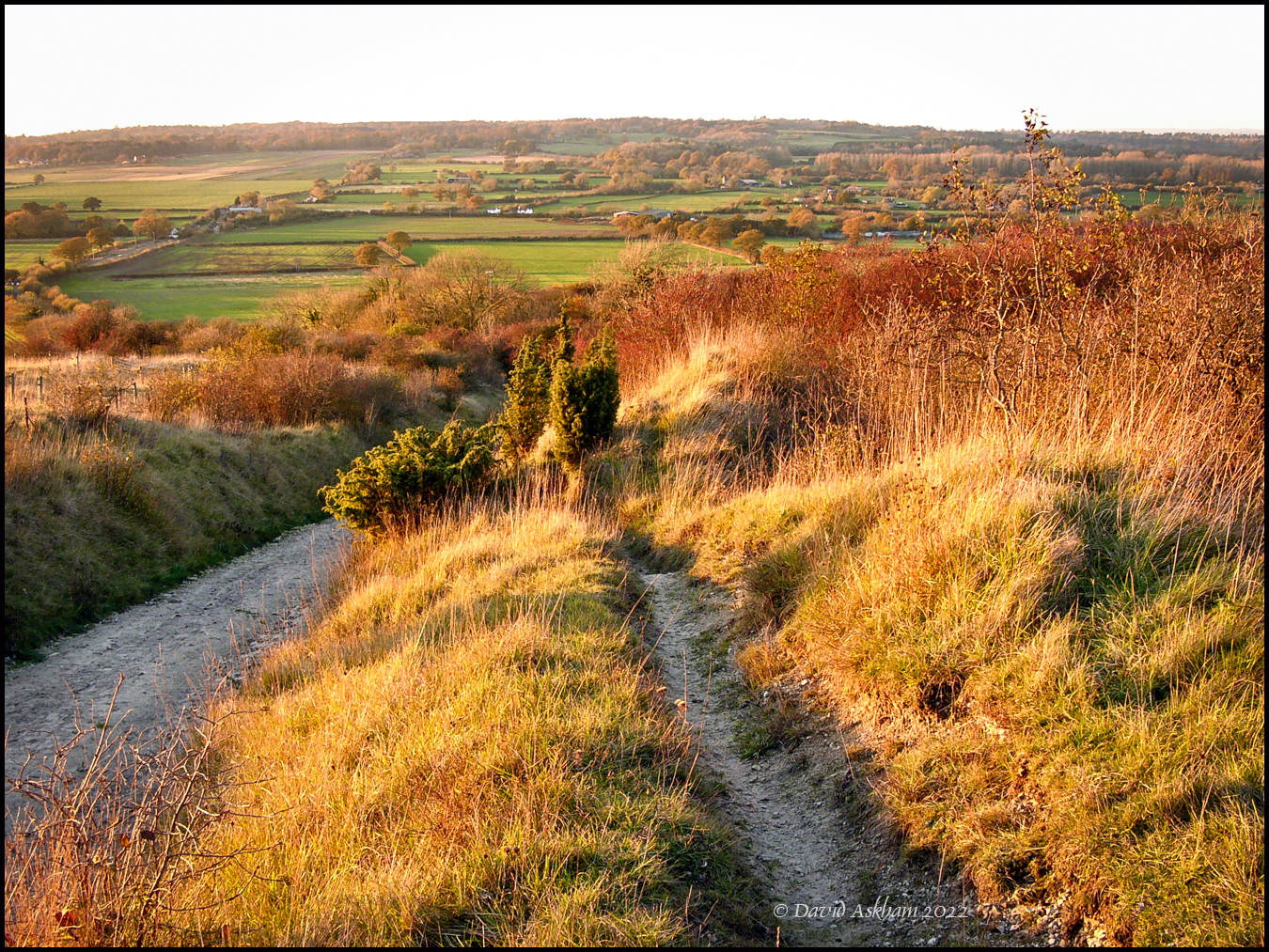Silently I stood, just beyond a former crossroads in an uninhabited corner of the countryside, listening. I carefully strained my ears and wondered whether I was too late to witness a passing stagecoach, plying between London, Bath and Bristol. Sadly I was too late. Probably 200 years too late.
All I could hear was birdsong, a pleasing experience, which is timeless. No sounds of road or farm traffic, or overflying Hercules aircraft; just near silence. Yet it was still worth my short journey, just to experience the solitude and let my imagination take a journey back in time.
Apart from the lack of traffic, practically nothing had changed over the years except for nature, who had grown a cloak of anonymity over the course of this one-time arterial link with cities to the east and west. Tree and shrub seedlings had perpetuated the verdant hedges before exposure to winds stunted their growth. Wild roses (Rosa canina) added colour in summer and autumn
Yet two centuries ago, this now overgrown right of way, cut across the North Wessex Downs, exposing their white chalky seams. Nearby, just out of sight, lies the sprawling small village of Heddington, near the Wiltshire town of Calne, itself situated on the famous Old Bath Road.
That busy route was itself rendered obsolete by the modern M4 motorway linking London with Bristol to the west, which was built in the 1960s. Later it was extended into South West Wales, from where livestock once made its way to the West Country.
That the historic route remains at all is remarkable. While a few cottages along it were inhabited in my lifetime, every trace has now disappeared. It remains the domain of ramblers and dog-walkers. I did not see many when I last visited this site. However I did capture a scene or two, a few of which are shown here.
I converted my main picture of this ancient route, in Lightroom to a version of monochrome, possibly split-tone, to evoke an atmosphere of period times. In contrast, the chalk seam picture has been given a more contemporary treatment, again simply fine-tuned in Lightroom. No recourse to the use of presets. I do occasionally use monochrome presets, but I usually end up adjusting the colour channels to give me the impression I seek. Very occasionally I use Silver Efex Pro 2, but only if I need to use the amazingly powerful control point technology to give me controls not so easily done in Lightroom.
I strongly suspect that this ancient way was also used by cattle drovers, who moved large numbers of animals across the West Country, and elsewhere too.
Almost certainly it would have been known to soldiers fighting in the English Civil War when Royalists met Parliamentarians. It was at the top of the hill that they joined battle on Roundway Down in 1643, just a mile or two beyond the point where I was standing.
Also on top of the Downs is Oliver’s Castle, part of an even older ancient fort, of which only earthworks remain. The area is steeped in history, and in my moment of appreciated silence, I can only conjure mental images of what life might have been like there, in ancient times. The landscape is now open and wild and largely unchanged. It is ideal for ramblers who do not have far to go to reach an excellent tavern or two. I cannot guarantee that it still looks like my pictures because it is several years since I last explored the route.
Two final comments on my pictures, which have been selected largely from forgotten folders. First, simple delightful scenes exist all around us. We take them for granted and largely ignore them. An Ordnance Survey map can yield surprising clues of interesting features in the landscape. Barely visible remains of old Roman roads and ancient byways serving villages which no longer exist. If accessible, explore them.
Second, my pictures used to illustrate this short feature were produced with digital cameras which might be found in a museum nowadays or could be collecting dust on a shelf. Yet, given the advances in digital processing, revisiting these old files brings forth surprising results.
The main picture was taken using a Leica Digilux 2, a 5MP camera fitted with a stunning Vario-Summicron lens. How sad it is that the lens was forced into early retirement, as technology progressed. It deserved a longer life. So, if you have any early digital files, already forgotten due to the pace of life, revisit a few and surprise yourselves. You might even question whether you really need the 60-megapixel sensors offered today.
Read more from David Askham
Make a donation to help with our running costs
Did you know that Macfilos is run by five photography enthusiasts based in the UK, USA and Europe? We cover all the substantial costs of running the site, and we do not carry advertising because it spoils readers’ enjoyment. Every amount, however small, will be appreciated, and we will write to acknowledge your generosity.





Hello David
I very much enjoyed reading your article although the photographic references were outside my realm of knowledge. The images are beautiful and so nostalgic. John and Michael would have been so proud of you as I am.It is a joy to realise that at your age you are still producing such excellent work.
With love, Jackie.
Thank you for your kind comments. It gives me great pleasure sharing ideas and encouraging others not to neglect their earlier work. When it is all too easy to forget past events, just a short glance at earlier work can stimulate the memory and help to relive joyous moments. And the only cost, is time; time which otherwise might be wasted.
Kevin, this comment belongs to your earlier comment starting at #6. Unfortunately, there is a limit on the number of entries as a sub-thread.
I .agree entirely with your desire to have ‘good light’ for such a journey. It transforms the countryside and allows many more opportunities for creative photography.
Your story brought back memories of my childhood in Wiltshire. Images of running along the tops of the hills of the downs with my cousins came back to me as though it was just a few years ago. Sixty years later it doesn’t seem to have changed much. That B&W picture is just lovely to look at. Thank you for the trip down memory lane.
Thank you Richard. I am pleased my story rekindled childhood memories for you. Are we not lucky to have landscapes which withstand the tests of time?
Very enjoyable, David. Concise, salient points well made.
Im with the others on your treatment of the first image. It gives it a mystical feel, stepping back into the past.
The second image is a nice catch too. Well seen.
Thank you, Wayne, for your appreciative remarks. Much appreciated.
A lovely bit of evocative storytelling! When I would come over and visit parents who lived in Southampton I would escape and drive towards Bath which one of the places in England I might call true home. I would drive up to Salisbury then north to Marlborough, before heading west on the Old London Road through Calne and on to Bath. While not as peaceful as walking it certainly feels like history is close to the surface and there to be scratched to see how life used to be lived. Thanks again!
It is surprising how many memories have been stirred by my short article. Thank you for your contribution. Glad you enjoyed my nostalgic stirring.
So good to see you use the Digilux 2 – a camera I like much better than my X-Vario (which probably should have been called the Dgilux 4). Both your first and your last picture are a real treat. There is just something about not only that lens but also the 5mp sensor which give a special feel to what they capture.
Thank you, John. It is comforting that I am not alone in retaining affection for the short-lived Leica Digilux 2. Although the skin is lifting in places, despite judicious use of adhesive, I prefer to keep it as it is. When I use it for general photography, just for the nostalgic experience, I never fail to be surprised by its silent operation. The results belie its age.
A step back in time, David, is exactly what this beautiful article means to me.
My first travel to England almost 30 years ago led me to… Calne. Believe it or not. As a young reporter, I had the opportunity to take part in a programme offered by the Rotary organization, and our exchange district happened to be Whiltshire and Dorset. With Calne as the first stop. We stayed with Rotarians and my host at Calne were a very gentle couple, I think he was a watchmaker.
My image of England was shaped by the tranquil countryside, a special hazy autumn light that made the colours shine in a unique and unforgettable way, and wonderful pubs. In some of them they drew the curtains after last orders, and one landlord gifted a well-used dominos game to me. I still cherish it as a memory of a trip that meant much to me.
In fact, this journey fostered my wish to study English. If I hadn’t done that I certainly would not write for Macfilos now! Later, I saw other parts of England that corresponded better to what I had expected from this country before this first trip. All these places were and still are great, but Whiltshire remained something special. Your article nourishes my wish to come back to this part of England. Not only for sentimental reasons.
So thanks a lot and probably I will write up some of my experiences from back then and add some of my now digitised slide scans. A certain role would certainly play the Rotary district conference that ended with a “last night of the proms” style concert. I can sing “Jerusalem” since then but keep feeling very bewildered every time I hear it.
So, a whole flood of memories come back. Thanks, David.
Best, Jörg-Peter
Jorg-Peter, your comments were a real joy to read. What a small world we inhabit! I am pleased your visit to England left you with so many happy memories and a strong desire to learn our language. As to the power of photography, had it not been for my delving into old files, we would not be exchanging these happy recollections today. Thank you.
.
Incredibubble: the first picture “..Picture converted to monochrome in Lightroom to recapture the historical connotations..” looks to me like full, but muted, colour ..with a preponderance of muted green almost everywhere. Perhaps because I’m expecting green!
My Beloved says it’s a kind of grey and beige ..though women are supposed to be NOT colour-blind!
How weird. It’s like this photo tinyurl.com/C0L0urLe55 ..which – apparently – has no colour in it. (My red/green colour vision is all over the place!)
..V-e-r-y restful..
Thank you, David B, for your interesting observations on colour perception. In fact, you touch on a topic of real interest and relevance. Some time ago, I started to draft an article on this subject, but it stalled for reasons I can’t remember right now. I might resurrect it for Macfilos.
Two immediate thoughts on your comments. One, it is rare to read a reference to husband and wife both having differing views on colour perception, and both at variance with others. The characteristic is much more prevalent in males. Second, my opening image is close to what Victorians often used, viz. Sepia, but not exactly. Sepia is not monochrome; it is a three-channel mix, giving a toned version of black and white. (I have just measured the foliage values in my first published image, which are typically R39 G36 B26) So the three of us clearly see the hues differently.
I am less interested in the precise values than the end result, which many viewers associate with old-time black and white photography. In fact, having just checked the history panel, my starting point for this picture was Lightroom 6 >Lightroom B&W Toned Presets> Antique Light. In contrast, the Sepia preset typically gives R43 G40 B32 with slightly less warmth. I wish I could show it here, but I doubt that is possible. I will ask the editor in due course.
That is enough analysis for now. It is the end result which matters, and I am pleased it finds favour with most viewers.
Beautiful
Just wonder what is monochrome: I mean sepia for instance has parts of red, green and blue as you say. Though an image with different intensities of that combination of G R and B (towards black or white) has actually a single color: sepia R43 G40 B32. That could work with any color of the spectrum. Maybe a question of reference, secondary colors are colors too, a single orange pencil does the work.
Very interesting question, George. Theoretically, monochromatic values of RGB should be individually equal. The result is clinically grey-scale tones. In my landscape, that is not the cold effect I wanted. Thank you for contributing to this discussion.
Thanks to you, David
After posting just watching in the computer some of the gum prints I do. They are monochromatic, in the sense they are photographs printed in just the color I choose. Any I can handle, forming an image. What I often have in mind as monochrom
A lovely article, with wonderful images – I really like the opening image, the processing is wonderful.
Thank you for sharing.
Dave
Thank you, Dave. The opening image bears close scrutiny, despite its meagre pixel count. I derived considerable pleasure from selectively fine-tuning the shaded areas. It restored life to aged vegetation. It is noteworthy that such processing was a mystery to me when I first produced the file.
The B&W images certainly evoke times gone by David
Thank you, Ken. It is psychological, I’m sure, how monochrome symbolizes olden times.
Thanks for this…I know the South Downs at the Eastbourne end, indeed I set out to walk the South Downs Way as a young lad…but that is another story.
I wish I had kept the Olympus E1 which had a wonderful sensor, much under rated.
I will have look again at my files.
Chris, you might well be surprised by what you find, hidden in those early folders. I hope you have added some keywords to help in your search.
Very nice read, David. Lovely images to support your words.
Thank you, Keith. Much appreciated.
Thank you, Jean. The lens used with the Pentax K10D was PENTAX-DA* 16-50 mm F2.8 ED AL[IF] SDM. The lens is still current today, although the camera has been superseded several times. The brand has an excellent record, which has been maintained by Ricoh, who bought it from Asahi, some years ago.
Thank you David for a great article and a wonderful set of images. The images from these old cameras are mesmerizing in their rendering and the processing is beautiful. I’d like to know what lens you used with your K10D. There’s a second-hand one that has been eyeing me at my local camera dealer for a while now. If my memory is good the camera still have the old CCD sensor.
Jean
You are very welcome, Kevin. What a pleasing combination; a lovely peaceful walk, plus a rail trip home. It was the enjoyment of rediscovering the scene in my first picture, which prompted me to write the short article. Thank you for commenting.
As I write I am on a train from Dorking to Redhill having walked to Dorking from Guildford. My route followed the North Downs Way with a short cut on a old drovers road so your article is opportune. I agree completely with your sentiments about the charms of the (in my case North) Downs. I like very much the first photo and that of the track curving into the distance with its monochrome treatment. Thanks for this.
Hi Kevin, We perhaps need an article on what you have found on your journeys, as this sounds very interesting to me – more so if the X Vario has been out there enjoying the English countryside. Best Dave
I agree. There is so much of interest, all around us, especially if you stray a little further from your home patch.
Humm, you’ve both got me thinking. Ironically I’ve carried the X Vario and X1 on my recent trips but the sky has been completely overcast. As Bill Bryson said, it was like living in a Tupperware box. I want to wait for some beautiful light.
Looking at our recent skies Im inclined to think it might be a long wait.🤣
But I will look forward to what you end up with.
Chris, thank you for your nostalgic contribution to my brief delving into the remnants of an ancient overland route. I remember the old Harris factory in Calne, quite an industrial blot on urban landscape. There was also a simple wharf on the west side of the main road opposite the factory, a terminal of a spur of an important narrow boat canal which, very slowly is being restored by volunteers.
Your story of the movement of pigs rekindles the importance of droving routes, cross country, at least until the new rail network was in place in the 19th century. The famous chalk white horses are still maintained to a good standard, Cherhill included. The Downs might lack the grandeur of more mountainous terrain, but they exude their own charms, and flora and fauna. Thank you for sharing your memories.
David
Thank you for writing such a delightful article. I agree with John that your photographs are very atmospheric.
My late uncle worked at the Harris Bacon Factory in Calne in the early 1950’s as an accountant. The family lived in the nearby village of Cherhill on the old A4 road. Opposite the village is the Cherhill White Horse carved into the chalk hillside. I remember the distinctive Wiltshire downs from all those years ago.
In 2014 my wife and I had a holiday in Calne. The bacon factory has long since gone but apparently one reason why it was located there is that it was on an old droving route from Bristol to London. Irish pigs would be shipped to Bristol and then driven up to London. Previously they were grazed in the Calne area but with the establishment of the bacon factory this was no longer necessary. There was also a ready supply of local Wiltshire pigs.
Chris
Interesting. Maybe a good subject for a future article?
John, thank you. I am pleased it struck a chord in you. So much of our landscape has a story or two, to tell. If not, our imagination can fill in the gaps.
DICK TURPIN AND MR DUVAL, and the rest of the best of the highwaymen would raise their hats to you! What atmospherics thank you thank you thank you.!